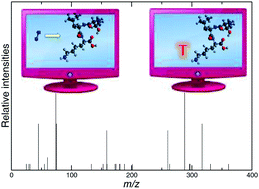当前位置:
X-MOL 学术
›
Phys. Chem. Chem. Phys.
›
论文详情
Our official English website, www.x-mol.net, welcomes your
feedback! (Note: you will need to create a separate account there.)
Chemical dynamics simulations of CID of peptide ions: comparisons between TIK(H+)2 and TLK(H+)2 fragmentation dynamics, and with thermal simulations†
Physical Chemistry Chemical Physics ( IF 2.9 ) Pub Date : 2018-01-02 00:00:00 , DOI: 10.1039/c7cp06818b Zahra Homayoon 1, 2, 3 , Veronica Macaluso 4, 5, 6, 7, 8 , Ana Martin-Somer 4, 5, 6, 7, 8 , Maria Carolina Nicola Barbosa Muniz 9, 10, 11, 12 , Itamar Borges 9, 10, 11, 12 , William L. Hase 1, 2, 3 , Riccardo Spezia 4, 5, 6, 7, 8
Physical Chemistry Chemical Physics ( IF 2.9 ) Pub Date : 2018-01-02 00:00:00 , DOI: 10.1039/c7cp06818b Zahra Homayoon 1, 2, 3 , Veronica Macaluso 4, 5, 6, 7, 8 , Ana Martin-Somer 4, 5, 6, 7, 8 , Maria Carolina Nicola Barbosa Muniz 9, 10, 11, 12 , Itamar Borges 9, 10, 11, 12 , William L. Hase 1, 2, 3 , Riccardo Spezia 4, 5, 6, 7, 8
Affiliation

|
Gas phase unimolecular fragmentation of the two model doubly protonated tripeptides threonine–isoleucine–lysine (TIK) and threonine–leucine–lysine (TLK) is studied using chemical dynamics simulations. Attention is focused on different aspects of collision induced dissociation (CID): fragmentation pathways, energy transfer, theoretical mass spectra, fragmentation mechanisms, and the possibility of distinguishing isoleucine (I) and leucine (L). Furthermore, discussion is given regarding the differences between single collision CID activation, which results from a localized impact between the ions and a colliding molecule N2, and previous thermal activation simulation results; Z. Homayoon, S. Pratihar, E. Dratz, R. Snider, R. Spezia, G. L. Barnes, V. Macaluso, A. Martin-Somer and W. L. Hase, J. Phys. Chem. A, 2016, 120, 8211–8227. Upon thermal activation unimolecular fragmentation is statistical and in accord with RRKM unimolecular rate theory. Simulations show that in collisional activation some non-statistical fragmentation occurs, including shattering, which is not present when the ions dissociate statistically. Products formed by non-statistical shattering mechanisms may be related to characteristic mass spectrometry peaks which distinguish the two isomers I and L.
中文翻译:

肽离子CID的化学动力学模拟:TIK(H +)2和TLK(H +)2断裂动力学之间的比较,以及热模拟†
使用化学动力学模拟研究了两个模型的双质子化三肽苏氨酸-异亮氨酸-赖氨酸(TIK)和苏氨酸-亮氨酸-赖氨酸(TLK)的气相单分子裂解。注意力集中在碰撞诱导解离(CID)的不同方面:碎裂途径,能量转移,理论质谱,碎裂机制以及区分异亮氨酸(I)和亮氨酸(L)的可能性。此外,讨论了由离子和碰撞分子N 2之间的局部撞击导致的单次碰撞CID活化与以前的热活化模拟结果之间的差异。Z.Homayoon,S.Pratihar,E.Dratz,R.Snider,R.Spezia,GL Barnes,V.Macaluso,A.Martin-Somer和WL Hase,J.物理 化学 甲,2016年,120,8211-8227。在热活化时,单分子断裂是统计的,并且符合RRKM单分子速率理论。模拟表明,在碰撞激活中,会发生一些非统计性的碎裂,包括破碎,这在离子进行统计解离时是不存在的。通过非统计粉碎机制形成的产物可能与区分两个异构体I和L的特征质谱峰有关。
更新日期:2018-01-02
中文翻译:

肽离子CID的化学动力学模拟:TIK(H +)2和TLK(H +)2断裂动力学之间的比较,以及热模拟†
使用化学动力学模拟研究了两个模型的双质子化三肽苏氨酸-异亮氨酸-赖氨酸(TIK)和苏氨酸-亮氨酸-赖氨酸(TLK)的气相单分子裂解。注意力集中在碰撞诱导解离(CID)的不同方面:碎裂途径,能量转移,理论质谱,碎裂机制以及区分异亮氨酸(I)和亮氨酸(L)的可能性。此外,讨论了由离子和碰撞分子N 2之间的局部撞击导致的单次碰撞CID活化与以前的热活化模拟结果之间的差异。Z.Homayoon,S.Pratihar,E.Dratz,R.Snider,R.Spezia,GL Barnes,V.Macaluso,A.Martin-Somer和WL Hase,J.物理 化学 甲,2016年,120,8211-8227。在热活化时,单分子断裂是统计的,并且符合RRKM单分子速率理论。模拟表明,在碰撞激活中,会发生一些非统计性的碎裂,包括破碎,这在离子进行统计解离时是不存在的。通过非统计粉碎机制形成的产物可能与区分两个异构体I和L的特征质谱峰有关。










































 京公网安备 11010802027423号
京公网安备 11010802027423号